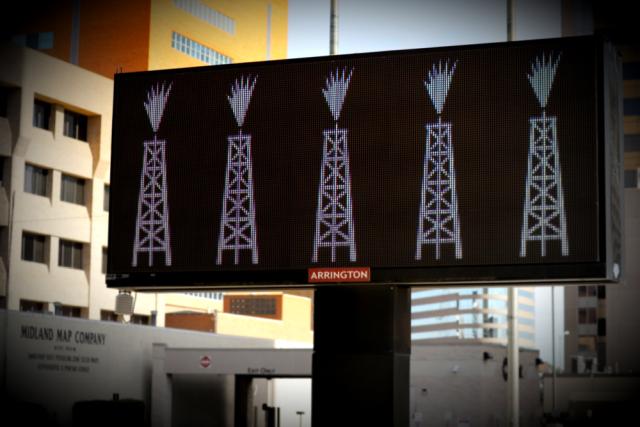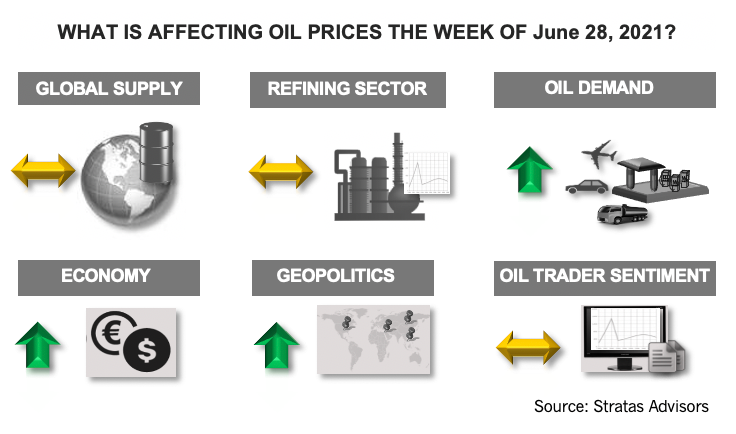
There is also a possibility that supply from U.S. and other non-OPEC oil producers will lag because of a combination of the inability to raise the required capital plus a focus on generating free cash flow and rebuilding balance sheets. (Source: Image of Downtown Midland, Texas sign by SG Arts / Shutterstock.com)
[Editor’s note: This report is an excerpt from the Stratas Advisors weekly Short-Term Outlook service analysis, which covers a period of eight quarters and provides monthly forecasts for crude oil, natural gas, NGL, refined products, base petrochemicals and biofuels.]
The price of Brent crude ended last week at $75.31 after closing the previous week at $73.22. The price of WTI ended the week at $74 after closing the previous week at $71.50.
In our note from last week, we put forth our view that the increases in oil prices will moderate during the third quarter of this year. This comes after Stratas Advisors accurately forecasted the major run up in prices since November of last year when the price of Brent crude fell to $37.94. At that time, we were forecasting that the price of Brent crude would average $60 during second-quarter 2021—and we were definitely an outlier in terms of our bullish forecast, which was based on the following:
- Expectations for greater rebound in demand than forecasted by the International Energy Agency and others. Our demand forecasts are based on our quantitative model that builds up demand at the country level by demand sector—and incorporates macro-level factors (such as GDP and the consideration of efforts to manage/reduce the impact of COVID-19), size and attributes of vehicle fleet, vehicle miles traveled and the role of alternative fuels.
- Expectations that there would be a limited supply response by U.S. producers, which was based on our well-level data and analysis and our assessment of drilling programs of U.S. producers.
- Expectations that the OPEC+ framework would remain in place and that Saudi Arabia would take necessary steps to support oil prices—and to get the required cooperation from Russia and other members.
- Expectations that Iran would be limited in its ability to increase oil exports because we thought it was highly unlikely that the Biden Administration would agree to a deal that would remove the necessary sanctions.
While we are forecasting that increase in crude prices will moderate there are risks to the forecast including the following upside risks:
- Our forecast entails an increase in supply to stay aligned with the rebounding demand. The forecasted supply increases come from the members of OPEC+, as well as from non-OPEC producers, including the U.S. Since the middle of last year, the U.S. production has remained around 11 million bbl/d, even though the price of oil has exceeded pre-COVID levels. There is a possibility that supply from U.S. and other non-OPEC suppliers lags because of a combination of the inability to raise the required capital and a focus on generating free cash flow and rebuilding balance sheets. Additionally, it is possible that OPEC+ will be slow to adjust supply to meet increasing demand.
- Another risk stems from the weakening of the U.S. dollar, which would put upward pressure on commodity prices, including oil prices. The U.S. dollar weakened slightly during last week with the U.S. Dollar Index declining from 92.22 to 91.81. However, the U.S. Dollar Index remains well above the key support level of 90 (if the U.S. Dollar Index drops below this level, it is likely to continue falling to around 80, which would put significant upward pressure on oil prices)—and it is our view that the U.S. dollar will strengthen through the rest of the year because of the rebounding U.S. economy, which is outpacing other western economies.
- A surprise uptick in demand could also cause oil prices to increase more than we are forecasting. However, we think that demand surprise is unlikely now that many of the major consuming countries have moved past the worst of COVID-19. For example, while U.S. demand for refined oil products has been picking up, the gap in percentage terms between demand in 2021 and 2019 has reached a plateau—gasoline demand continues to run about 5%-6% below that of 2019, diesel demand is running nearly on par with 2019, but slightly lower, and jet fuel demand continues to run about 25%-30% below that of 2019.
RELATED:
OPEC Forecasts Point to Oil Supply Deficit in August
There are also downside risks to our forecast, including the following:
- A major downside risk continues to stem from COVID-19 and variants—currently the Delta variant that was first identified in India. The Delta variant is 40% more contagious but does not seem more deadly. Furthermore, it affects people in their 20s and 30s more so than older age groups, which could cause cases to rise because the bulk of the people in the younger age groups have yet to be vaccinated—but unlikely an increase in deaths. The vaccines appear to be effective against the variants, although there have been cases of fully vaccinated individuals getting COVID-19 from the variant. However, such cases are expected, given that the vaccines are not 100% effective.
- Another risk stems from a nuclear agreement that would allow Iran to increase crude exports to pre-sanction levels, which would result in an additional 1.5 million to 2 million bbl/d of crude oil being placed into the global market. Such a development could trigger a reaction from some of the OPEC+ members, and more barrels being supplied because of producers fearing a loss of market share.

About the Author:
John E. Paise, president of Stratas Advisors, is responsible for managing the research and consulting business worldwide. Prior to joining Stratas Advisors, Paisie was a partner with PFC Energy, a strategic consultancy based in Washington, D.C., where he led a global practice focused on helping clients (including IOCs, NOC, independent oil companies and governments) to understand the future market environment and competitive landscape, set an appropriate strategic direction and implement strategic initiatives. He worked more than eight years with IBM Consulting (formerly PriceWaterhouseCoopers, PwC Consulting) as an associate partner in the strategic change practice focused on the energy sector while residing in Houston, Singapore, Beijing and London.
Recommended Reading
TotalEnergies Starts Production at Akpo West Offshore Nigeria
2024-02-07 - Subsea tieback expected to add 14,000 bbl/d of condensate by mid-year, and up to 4 MMcm/d of gas by 2028.
E&P Highlights: Feb. 5, 2024
2024-02-05 - Here’s a roundup of the latest E&P headlines, including an update on Enauta’s Atlanta Phase 1 project.
CNOOC’s Suizhong 36-1/Luda 5-2 Starts Production Offshore China
2024-02-05 - CNOOC plans 118 development wells in the shallow water project in the Bohai Sea — the largest secondary development and adjustment project offshore China.
US Drillers Cut Oil, Gas Rigs for First Time in Three Weeks
2024-02-02 - Baker Hughes said U.S. oil rigs held steady at 499 this week, while gas rigs fell by two to 117.
Equinor Receives Significant Discovery License from C-NLOPB
2024-02-02 - C-NLOPB estimates recoverable reserves from Equinor’s Cambriol discovery at 340 MMbbl.




